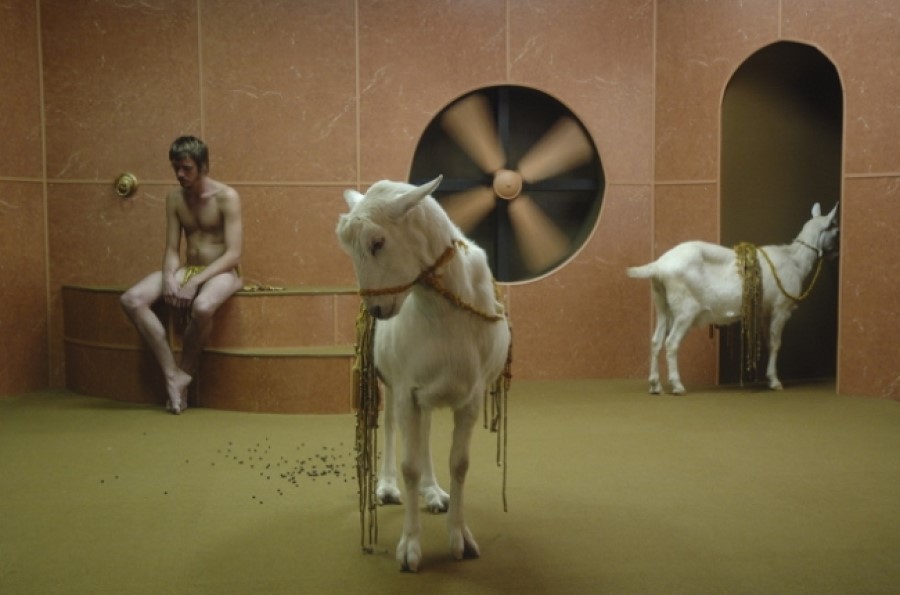The seemingly pointless and random sequence also evokes the human condition.
Image: Hayden FOWLER, Nursling III, 2006, mounted digital photograph, 80.0 x 120.0 cm, photographer Michael Randall, © the artist
HAYDEN FOWLER (NSW)
Born 1973, Te Awamutu, New Zealand
Hayden Fowler's stills and videos also have a strong sense of theatrical narrative. Fowler's animals operate instinctively within a highly sanitised set or background, but represent aspects of human nature.
Fowler grew up observing animals on his grandparents' farm in New Zealand. His first degree was a Bachelor of Science (biology), and the work expresses real empathy with his subjects. These short films are very hands on – Fowler builds the sets, choreographs the action and films and edits the final work. He also manages the animals – the cast for Hunger were in his Sydney studio for days.
In Goat Odyssey, two brocaded goats move through a highly artificial and sterile set (tiled walls like a bathhouse, green carpeted floor, and industrial fan on the back wall). Doors to off stage are built into the set. Frames move on a non–sequential basis, showing goats variously entering, leaving, standing, performing, or on the small stage at the back of the set. At times a goat paws – one foot, then the other – expressing something of the frustration and repression inherent in the ambiguous narrative. While goats are an archetype, and have long been part of human history (our only longer history with animals is in our relationship with dogs), they may symbolise fertility, vitality, energy.
In Fowler's odyssey, the movements of frames are labyrinthine, a reference to the non linearity of computer games. The seemingly pointless and random sequence also evokes the human condition. Photographic stills, shot independently as separate works from the video, incorporate a man, naked but for a loin cloth which matches the goats' drapery.
Hunger also takes as its subject sexuality and desire. In this double-framed sequence, on the right, another tiled background – this time dark – drips milk from an invisible teat in the wall. Here the milk drips and pools whitely on the black tiles, wasted. In the frame on the left, lambs come and go from a similar teat, falling to their knees in the way of lambs, tails wagging feverishly with the joy of hunger sated.
There is a political dimension to Fowler's narratives. Hunger's lambs parallel the profligate waste of the first world with the desperate poverty of the third. The goats in Goat Odyssey, the mice driven through the set in White Australia, and the cock in White Cock are following an imposed order, impotent and powerless despite the expression of instinctive behaviour.
Louise Martin–Chew from her Samstag essay, Alternative Realities
2008 Anne & Gordon Samstag International Visual Arts Scholarship
2008 Research Scholar, Weissensee Kunsthochschule Berlin
2006 Master of Fine Art, College of Fine Arts, University of New South Wales, Sydney
2002 Bachelor of Fine Arts (Honours), College of Fine Arts, University of New South Wales, Sydney
1995 Bachelor of Science, University of Waikato, New Zealand
Artist's website
http://haydenfowler.net/

